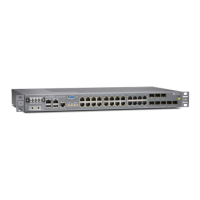CHAPTER 37
Configuring RFC 2544-Based
Benchmarking Tests
•
RFC 2544-Based Benchmarking Tests Overview on page 1335
•
Layer 2 and Layer 3 RFC 2544-Based Benchmarking Test Overview on page 1338
•
Configuring RFC 2544-Based Benchmarking Tests on page 1341
•
Configuring Ethernet Loopback for RFC 2544-Based Benchmarking Tests on page 1355
•
RFC 2544-Based Benchmarking Test States on page 1358
•
Example: Configuring an RFC 2544-Based Benchmarking Test for Layer 3 IPv4
Services on page 1359
•
Example: Configuring an RFC 2544-Based Benchmarking Test for NNI Direction of
Ethernet Pseudowires on page 1367
•
Example: Configuring an RFC 2544-Based Benchmarking Test for UNI Direction of
Ethernet Pseudowires on page 1375
RFC 2544-Based Benchmarking Tests Overview
RFC 2544 defines a series of tests that can be used to describe the performance
characteristics of network interconnecting devices. RFC2544-based benchmarking tests
methodology can be applied to a single device under test (DUT), or a network service
(set of devices working together to provide end-to-end service). When applied to a
service, the RFC2544 test results can characterize the Service-Level-Agreement (SLA)
parameters.
RFC 2544 tests are performed by transmitting test packets from a device that functions
as the generator or the initiator. These packets are sent to a device that functions as the
reflector, which receives and returns the packets back to the initiator.
ACX Series routers support RFC 2544 tests to measure the following:
•
Throughput
•
Latency
•
Frame loss rate
•
Back-to-back frames
1335Copyright © 2017, Juniper Networks, Inc.

